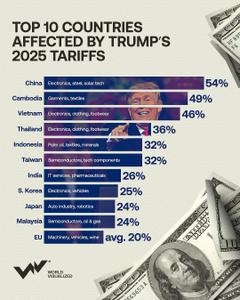inflation

Maps / 6 weeks ago
Over 40 million residents in Europe were born outside the EU
According to data available on January 1, 2024, 44.7 million people living in the EU were born outside the Union (about 9.9% of the population). A further 17.9 million were born in another EU country. Together, these groups explain much of the bloc’s population growth and a growing share of its workforce. By absolute size, Germany hosts the EU’s largest foreign-born population (15.8 million), followed by France (10.1 million), the UK (9.6 million) and Italy (6 million).

Business / 8 weeks ago
Germany’s $4.6 trillion economy rivals over 20 European nations combined
Germany’s economy remains a powerhouse — so large that its 2024 GDP equals the combined economic output of more than 20 European countries across Eastern and Northern Europe. With a nominal GDP of about $4.66 trillion, according to the World Bank and Trading Economics, Germany continues to dominate the European economic landscape despite recent headwinds.

Business / 9 weeks ago
How many years of work does it take to buy one bitcoin?
In 2025, Bitcoin has once again captured headlines as prices remain near historic highs. According to data from the IMF’s 2025 World Economic Outlook, the number of years an average worker would need to save to buy a single Bitcoin ranges from just one year in the richest countries to over four decades in the poorest. This visualisation is as much about global inequality as it is about crypto adoption. In North America, Western Europe, and parts of Asia, where incomes are highest, the cost of one Bitcoin is roughly equivalent to one to three years of earnings.
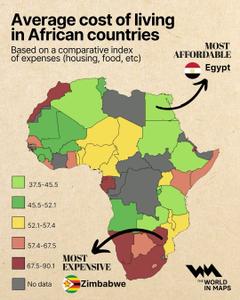
Politics / 12 weeks ago
Cost of living in Africa: Egypt most affordable, Zimbabwe most expensive
A new analysis of living costs across Africa shows striking differences between countries. Based on a comparative index of expenses such as housing, food, and transportation, Egypt ranks as the most affordable country, while Zimbabwe is the most expensive. The map, compiled from Numbeo’s 2024 Cost of Living Index and supported by other regional data, highlights how daily expenses vary widely across the continent.
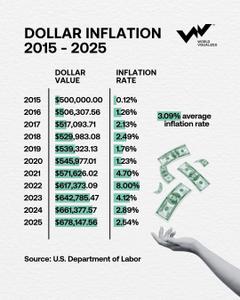
Business / 15 weeks ago
U.S. dollar sees significant inflation surge from 2015 to 2025, peaking in the pandemic aftermath
Over the past decade, the U.S. dollar has experienced a steady yet noticeable erosion in purchasing power, with cumulative inflation pushing the nominal value of $500,000 in 2015 to a staggering $678,147.56 by 2025. This represents a cumulative inflation growth of approximately 35.6%, according to data compiled by World Visualized using figures from the U.S. Department of Labour.
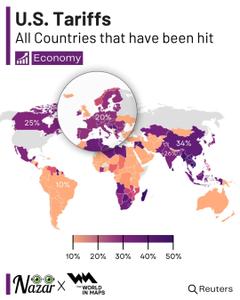
Business / 31 weeks ago
The real victims of Donald Trump's 'Liberation Day' reciprocal tariffs
President Donald Trump's recent implementation of sweeping tariffs has ignited extensive debate and concern, particularly regarding their impact on American consumers and small businesses. These tariffs, which impose a 10% levy on all imports—with higher rates for specific countries such as China (34%) and Japan (24%)—are projected to have significant economic repercussions.

Business / 35 weeks ago
How economic conditions are impacting the average hourly wages in Europe
The European economy has experienced significant fluctuations in recent years, influenced by factors such as inflation, unemployment, and GDP growth. These economic conditions have a profound impact on average hourly wages across Europe. According to data from Eurostat, the statistical office of the European Union, we can gain valuable insights into the relationship between economic conditions and average hourly wages. Inflation plays a crucial role in determining average hourly wages. When inflation rises, the purchasing power of consumers decreases, and employers may need to adjust wages to maintain employees' standard of living. Eurostat data reveals that countries with high inflation rates, such as Hungary and Poland, have experienced significant growth in average hourly wages (€12.8 and €11.9 respectively) between 2023 and 2024.

Business / 37 weeks ago
The biggest growth drivers of Asia's economy in 2025
According to the International Monetary Fund (IMF), global growth will be 3.3% in 2025, with Asia expected to be a key growth driver. China tops Asia's economic charts, with Japan and India following closely. Together, these three nations command a substantial 66.2% share of the continent’s economy. South Korea and Indonesia round out the top five, while the leading eight economies collectively account for 82% of Asia's total economic output. Conversely, Timor-Leste represents the smallest economy in the region.
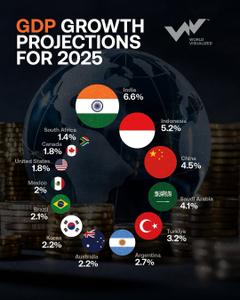
Business / 38 weeks ago


